
views
Prepping Your Body for a Faster Run

Eat the right diet. By improving your eating habits, you will decrease your body fat and fatigue, while gaining muscle and endurance. Not eating right could be what is holding you back from breaking your 800m record. Eat a variety of wholesome foods like fruits, vegetables, whole grains, and lean meats. This will improve your body composition. Increase protein and the right amount of carbohydrates, as these will provide your body with the nutrients to build muscle and to give your body energy. If you’re training for 30-45 minutes, shoot for about 3 grams (0.11 oz) of carbs on training days. If you’re training for 46-60 minutes, shoot for about 5 grams (0.18 oz) of carbs on training days. Avoid processed high-sugar and high-sodium foods. These will hinder your body from running efficiently. Eat the right pre and post-workout carbohydrate-rich snacks. These should be consumed an hour before working out and within 30 minutes after a workout. Bananas, protein shakes and non-caffeinated energy bars are ideal.

Keep properly hydrated. Your body needs about two liters on an average day to stay properly hydrated.On days when running, you need to drink extra water to compensate for your output and prevent yourself from slowing down. Don’t just chug extra water though; listen to your body and drink when thirsty. Pre and post-workout hydration is vital. An hour before you start your run, try to drink about 16 ounces (450 g) of water. Drink the same amount of water after running. Look for signs of dehydration. Feeling thirsty or experiencing dry mouth, headaches, light-headedness, lack of urination and constipation are all the body's ways of letting you know that you are dehydrated. If you begin to experience any of these symptoms, it's best to increase your water intake.

Stretch properly. By stretching properly, you can improve your stride and your stride length (increasing your speed). Stretching before and after your workout will also help to prevent injury. Muscles to stretch include your leg muscles (hamstrings, quadriceps and adductors) and your lower body (hip flexors and glutes). Try to add two or three longer stretch routines a week to your workout schedule. Do some yoga to help you with your flexibility.
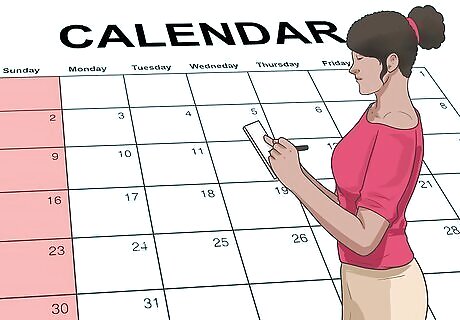
Set a training schedule. You won’t be able to run a faster 800m in one day. Just like training for a marathon, the best way to achieve your goals is to set a schedule. By following a training plan you can perform at a peak performance, even when running a shorter distance. Set an end date and work backward. Even with an 800m run, pick a date that you want to accomplish this run with your best time ever. Do one or two quality and intense workouts a week. These include running hills or tempo runs. Pick rest days where you can do some other sort of moderate exercise like yoga to stay limber. Ensure that you get enough sleep before the race.
Training Your Body
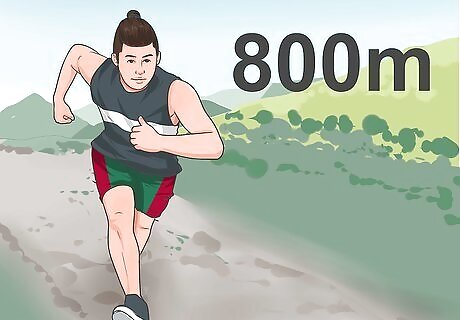
Understand the mechanics of your run. The 800m run is a middle-distance race. These rely on the runner being able to maintain a fast pace throughout the race and then being able to sprint in the last stretch. Working out is going to require you to hone in on the following three abilities: Develop middle-distance running mechanics. This is also known as speed-stamina. You're going to need to establish a fast pace for the beginning of the race while maintaining control of your body. The goal is to be able to maintain a comfortable, but fast pace throughout the run, keeping in mind that you will exert a lot of energy in a full sprint at the end of the race. Learn to run in runner traffic. People who run an 800m race will have to deal with runner traffic on the inside of the track. Train yourself to minimize being caught in the pack by running in groups to learn how to be conscious of your running form without clipping the person in front of you. Run anaerobically. The last half (350-400 meters) of the race, your body will often feel fatigue from your almost sprint-like speed. Build this ability by sprinting 400m at a faster than normal pace; then walking for 2 minutes before repeating. This interval training will improve your anaerobic fitness.
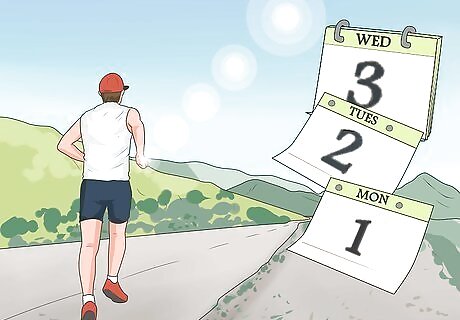
Run often. Run most days, alternating 400m and 1600m distances. Focus on what attributes best match the 800m. Use the 400m to develop speed in sprinting. Use the 1600m to develop a high-speed endurance pace. Refer to your training schedule. Remember to take rest days to stretch and continue eating a healthy diet to fuel for your next run. Also go on runs that will train your body in different ways, like hill running to improve leg muscles and cardiovascular strengthening. Usain Bolt Usain Bolt, Olympic Sprinter Persevere through the challenges. "The difference between the impossible and the possible lies in determination."

Rest and recover. Always follow hard days with easier days. After a hard workout, give your body time to recover by either resting or doing a lighter workout. While you typically want to be somewhat active on rest days, you also need to allow your body to truly rest. This means that you get enough sleep and keep a consistent sleep schedule. Don’t run on an injury. If you experience an injury, stop training, and see a doctor so you don’t injure yourself further.
Running The Race

Hydrate and energize your body. An hour before the race, have a high-carbohydrate snack and 16 ounces (450 g) of water. You want to give your body the right nutrition to energize, but you don’t want to overdo it by eating too much. Before running, eat a snack instead of a whole meal as that means fewer calories your body has to try and process during your race. Consider fruit or yogurt, or a cereal bar to give you energy without making you feel bloated and sluggish.

Stretch your muscles. Make sure that your body is loose and ready to run. With a quick, proper stretch, you can loosen up your muscles and increase your stride while decreasing risk of injury and cramping during your run. Stretch your hip flexors, thighs, hamstrings, calves, and lower back.
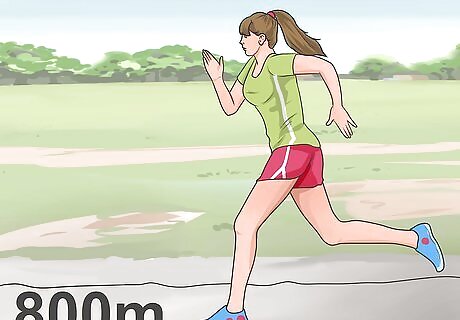
Run your 800m. A basic rule in middle distance races (800 and 1600 meters) is that a runner must maintain a fast pace and maintain enough energy to have two bursts of acceleration. Start of the race off right. Run fast at a speed that you can maintain well. Consistency is key here. Be smart in the middle of the race. Be conscious of the other runners and your changes in pace. You will need the energy to sprint at the beginning and end of the race. Use the first acceleration to merge into the inner lanes and get as close to the front of the pack as you can. Be conscious of when you are over exerting yourself so that you have enough energy for the second acceleration at the end of the race. You want to maintain a consistent pace until it’s time to accelerate; don’t let other runners affect your pace. In the last 200m or 300m, begin to sprint at full pace. This is where the anaerobic training comes in. Push your body, using your last acceleration to pass the pack leaders and win the race.
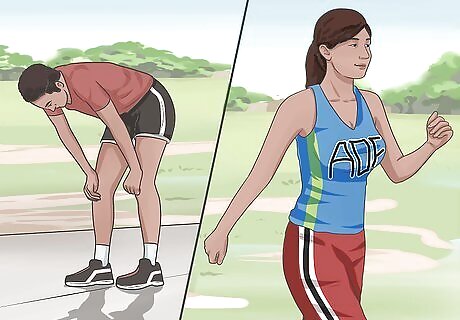
Cool down. Properly cooling down after your run is just as important as your training. A proper cool will prevent injury and help ease your body back into a normal state. Walk for a couple of minutes, starting at a brisker pace then transitioning to a slower walk to allow your heart to ease back into its normal rhythm. Stretch again for 5-10 minutes to ensure that your muscles don’t tighten up too much from working so hard.


















Comments
0 comment